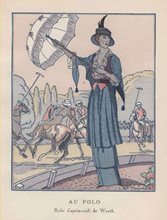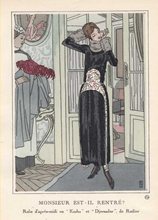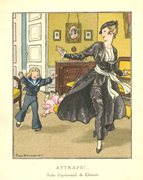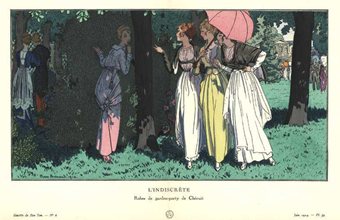Gazette du Bon Ton. Arte - Mode et Frivolités (Journal of Good Style. Art, Fashion & Fun), or.. Gazette du Bon Ton. Modes et manieres d'aujourd'hui (Journal of Good Style. Fashion and Manners of the Day): a coveted periodical by both names, it was intended for the elite and was expensive (annual subscription of 100 francs is more than $400 today). Published in Paris ten times most years from 1912 to 1925, its editor Lucien Vogel and distributor Condé Nast took over Gazette du Bon Ton in 1925, and then began Vogue magazine.

Unlike Vogue magazine today, the beautiful fashion illustrations for Gazette du Bon Ton were each painted by hand, and inevitably were more popular than the magazine's articles about privileged lifestyle. The finest fashion artists of the day were employed to illustrate the latest elegant designs. Production of these pochoirs was labour-intensive. Each illustration required up to thirty individual stencils to be cut. Each was carefully superimposed for applications of ink and watercolour to build up the detail of each image. Pochoirs were then attached to slips of paper for stapling into a paper cover so that they would not be damaged - and to enable easy removal for framing to hang on the wall.
 The French word 'pochoir' meaning stencil, is universally used for these lovely fashion images that show French mastery of this process. Gazette du Bon Ton had exclusive contracts with seven elite couture houses in Paris, so that these designers' fashions were shown only in their pages. It was the first time that designers were publicly acknowledged for their fashion creations. A few of the artists were also designers and include pochoirs of their own work.
The French word 'pochoir' meaning stencil, is universally used for these lovely fashion images that show French mastery of this process. Gazette du Bon Ton had exclusive contracts with seven elite couture houses in Paris, so that these designers' fashions were shown only in their pages. It was the first time that designers were publicly acknowledged for their fashion creations. A few of the artists were also designers and include pochoirs of their own work.
 Regular artists were George Barbier, Pierre Brissaud, André-Edouard Marty, Thayaht (Ernesto Michahelles), George Lepape, Charles Martin, Étienne Drian, Maurice Taquoy, Eduardo Garcia Benito, and the David sisters.
Regular artists were George Barbier, Pierre Brissaud, André-Edouard Marty, Thayaht (Ernesto Michahelles), George Lepape, Charles Martin, Étienne Drian, Maurice Taquoy, Eduardo Garcia Benito, and the David sisters.
All had distinctive artistic styles, providing wide public appeal, - and on occasion they imitated each other’s style. The most influential artist was George Barbier. The most radical interpretations were by Thayaht.
Rare double-size pochoirs provide a more detailed fashion narrative with suitable settings showed where and how clothes should be worn.

Humorous titles were often added - which increase their appeal, as in "Indiscretion" at right. Gazette du Bon Ton also included simple Croquis (sketches) with new fashions against plain backgrounds. The pochoirs are all charming, and even find approval with men - probably because the ladies are always looking so poised and refined.
I love fine fashion pochoirs, so there is a great selection available from our website...
For further information phone +61(0)412 442 283 or email sales@antiqueprintclub.com ... or arrange a visit to the Antique Print Clubhouse at Neranwood in the Gold Coast Hinterland.